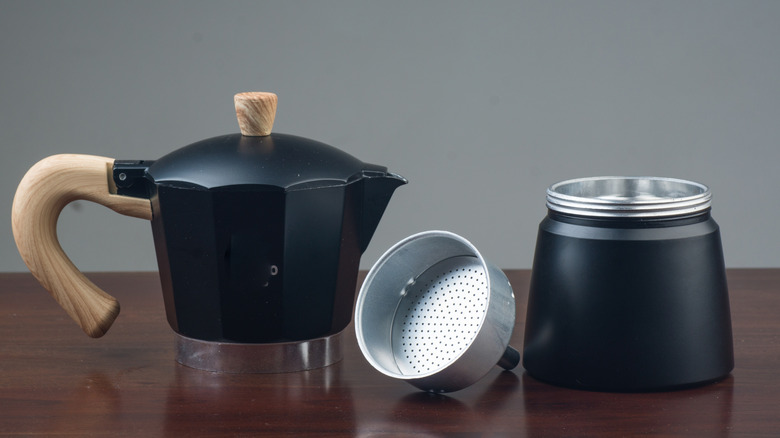How To Properly Clean Your Moka Pot
Brewing coffee at home can be as simple as loading a pod into a Keurig and pressing a button, or as complicated as grinding, leveling, and tamping coffee into the portafilter of a top-tier espresso machine. Somewhere in between these two extremes is the moka pot, often referred to as a "stovetop espresso maker" (although it doesn't technically produce espresso, but rather a slightly stronger coffee. You can still use a moka pot to make a latte, though). This iconic brewer became an Italian staple around the 1930s, when Alfonso Bialetti began producing the Moka Express in his aluminum workshop. Thankfully, you don't have to live in Italy to enjoy moka pot coffee.
The moka pot is essentially two halves, one on top of the other, with a coffee filter sandwiched between. Water placed in the bottom portion is heated on the stovetop; pressure pushes it through the coffee in the middle, and up until it fills the top half of the pot. From here, you can tip it out into your waiting mug. The process is pretty simple, and thankfully, cleaning your moka pot is just as simple, if not more so. The device is best cleaned regularly with only warm water , with occasional deeper cleans using natural ingredients like vinegar, baking soda, and lemon juice. Never stick your moka pot into the dishwasher, as that can harm the metal. And don't use soap, unless you're intrigued by the sound of detergent-flavored coffee.
A few more considerations for cleaning a moka pot
When doing your everyday clean using warm water, take the time to let the pot dry before reassembling it. Bialetti recommends using a clean cloth to dry the pot; this can help keep it free of water stains. However, many moka pot users admit to simply letting it air dry. In either case, if you fail to let your moka pot dry thoroughly, the metal can oxidize, giving your coffee an icky, metallic taste. This is particularly true if you're using an aluminum moka pot, which Bialetti produces. Other brands do make steel moka pots, which actually can be placed in the dishwasher. However, handwashing steel pots is still preferable, as detergents can still affect the coffee's taste.
If you do notice your coffee tasting slightly "off," or if you notice a buildup of limescale (a whitish residue made up of minerals found in water), it is probably time for a deeper clean — again, using natural products such as baking soda, vinegar, and lemon juice. Scrub the pot gently with your cleaning solution until the limescale disappears. It's also good practice to use filtered water rather than tap water for brewing coffee, as there are fewer minerals that may be left behind.
Finally, your moka pot will have a rubber gasket that helps seal the top and bottom parts together. Keep this clean by removing it periodically and rubbing it with a wet cloth. Eventually, this will need to be replaced — about once a year. If you follow these steps for cleaning and maintaining your moka pot, you'll have tasty coffee for years to come.

